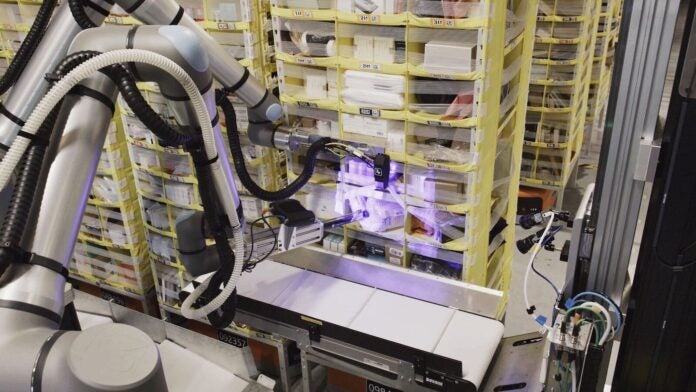Amazon unveiled on Wednesday the company’s first robot to have a sense of touch. The tech giant introduced the Vulcan robot model during its annual Delivering the Future event, held in Dortmund, Germany this year.
Vulcan represents a significant improvement over typical fulfillment robots, which Aaron Parness, Amazon director of applied science, described as “numb and dumb” due to their lack of sensors.
Vulcan improves on previous Amazon robots
Vulcan is not the first Amazon robotics model that can pick up items. Older systems — including Sparrow, Cardinal, and Robin systems — use a combination of suction cups and computer vision to move single items around. Those robots can also move packages that have already been packed by humans.
However, those earlier robot models struggled to retrieve items from the small fabric pods that Amazon uses to store inventory in fulfillment centers. The pod’s compartments are only about one foot square and contain up to 10 items, and older models didn’t have the finesse to remove one object without risking damage to others.
Robot with sense of touch is a leap forward for Amazon
Vulcan is different from previous models because of this sense of touch, which Amazon describes as “its ability to understand when and how it makes contact with an object.” Its force-feedback sensors measure grip strength, allowing the robot to remain below the damage threshold when handling items. Vulcan also features an additional arm that can gently push surrounding objects out of the way.
Amazon says the Vulcan model was made possible thanks to key advancements in robotics, engineering, and physical artificial intelligence. “Vulcan represents a fundamental leap forward in robotics,” Parness said in the company’s announcement. “It’s not just seeing the world, it’s feeling it, enabling capabilities that were impossible for Amazon robots until now.”
Will the Vulcan robot assist or replace fulfillment workers?
Amazon did not specify how many jobs the Vulcan model may create or displace. However, the company said its robotics systems have led to “hundreds of new categories of jobs at Amazon,” including roles focused on training, operating, and maintaining the robots.
Amazon emphasized that Vulcan demonstrates how automation and AI can assist warehouse employees with everyday tasks. Initially, the robot will be used to retrieve items from the top and bottom rows of storage pods — tasks that typically require employees to climb step ladders or bend down.
Read eWeek’s coverage about the top robotics companies revolutionizing automation, as well as the push for a US robotics strategy.
